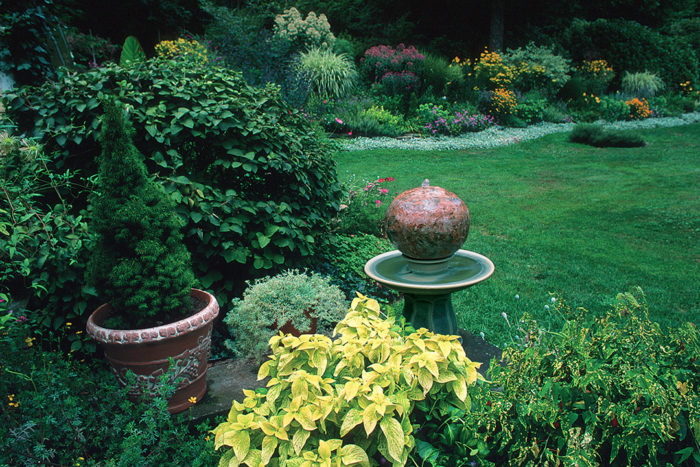
Years ago, my husband and I spent some time in California and were very taken with the Napa Valley. We even toyed with the idea of living there, but when the dry season came and the hills turned brown, we felt homesick for Connecticut, the smell of rain, and the color green.
Nature, of course, is not sentimental about color. Her preference for green is entirely practical. It is the color of life and, wherever there is sufficient rainfall, the prevailing color of the natural landscape. Using the sun’s energy, the pigment molecules in chlorophyll magically convert carbon dioxide and hydrogen into carbohydrates, which sustain both plants and animals, including us. Green leaves pump oxygen into the atmosphere, allowing us to breathe; we exhale carbon dioxide, providing plants with the raw material of food production.
Besides its critical role in this ingenious exchange, the color green is a soothing, middle-of-the-spectrum hue that is easy on the eyes. The electromagnetic wavelengths that produce this agreeable color are of medium length and require less effort and adjustment than the long wavelengths of red or the short ones of blue.
Regrettably, the undemanding nature of green led to its excessive use during the forties and fifties in schools and hospitals. According to The Color Compendium, by Augustine Hope and Margaret Walch, “institutional green” inspired loathing in an entire generation. Although of that generation, I have the highest regard for the color that I now consider the single most important hue in any temperate zone garden. However, in my early gardening days, I barely gave it a nod, so enthralled was I with the brilliant panoply of daylily colors. As daylilies (Hemerocallis spp. and cvs., USDA Hardiness Zones 3–10) were the first plants to flourish in my inexperienced hands, I pledged allegiance to their vivid reds, flaming oranges, and glowing yellows and golds.
Daylilies in these hues are still the backbone of my summer border, but I’ve come to realize that their effectiveness depends on their leaves and the contrast between the hot flower colors and the cool green of the foliage. If the leaves are fresh and unblemished, the bright colors sing; if not, they suffer. In gardens and in nature, green is the secret of all successful color schemes.
Green is the best background color
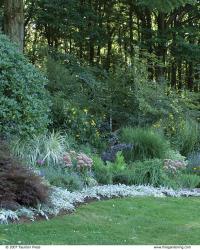
Photo/Illustration: Steve Silk
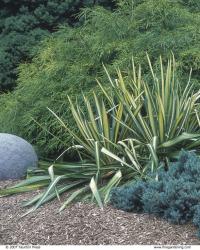
Photo/Illustration: Kathy Diemer
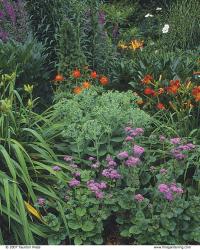
Photo/Illustration: Steve Silk
As nature has amply demonstrated in field and forest, green is the ideal background color. Garden designer Betty Ajay calls it the sovereign color of summer because it covers such vast areas of the earth’s surface during the growing season. The cooling mantle of green absorbs heat and, at the same time, shows off the colors of seasonal flowers.
A colorful flower bed always looks best in a verdant setting. In the case of my perennial border, this was easy to provide. Our property is entirely surrounded by state forest. Within our clearing, the main border follows the contours of an east-facing slope, where rhododendrons stand up to the tall woodland trees. Two smaller borders are linked to the natural landscape by an evergreen garden. Against the dark-green walls of the forest, the lighter colors and varied forms of ornamental trees, grasses, deciduous shrubs, and perennials create interesting silhouettes.
In the absence of a woodland setting, you can create a pleasing backdrop with a hedge. Evergreens such as yews (Taxus spp. and cvs., Zones 4–10), hemlocks (Tsuga spp. and cvs., Zones 4–9), and hollies (Ilex spp. and cvs., Zones 5–9) are particularly suitable because of their uniformly dark-green foliage.
Easy-going green creates harmony in any setting
In flower beds, green performs a role for which it is uniquely suited, that of peacekeeper. Neither as self-effacing as blue and violet, nor as pushy as red, orange, and yellow, green is just there, dependable and noncompetitive. Any medley of hues can be reconciled by the presence of enough green foliage.
How much is enough? The more, the better. Again, nature shows the way. The colors in a meadow of wildflowers are unplanned, but the effect is always harmonious, thanks to the prevalence of green. Similarly, the random colors in a cottage garden seldom clash. But in the rare event that they do, more green—not white—is the best antidote. White is too light, too bright, and too demanding to perform such a mundane service. Leave it to green to restore harmony.
In the catch-all perennial bed behind our garage, an abundance of green leaves prevents disparate shades of pink from clashing. A distinctly blue-pink yarrow cultivar found a home, intended as temporary, next to a daylily with warm-pink flowers. I was fully prepared to move one or the other, but green came to the rescue and made such heroic measures unnecessary. The daylily’s lush, arching leaves combined with the feathery, dark-green foliage of the yarrow took the curse off the inappropriate color scheme.
The shades of green
There are only two basic motifs for using color in the garden: contrast and harmony. Juxtaposing colors that are unalike results in contrast; putting together similar colors produces harmony. Green contrasts with hot colors, such as red and yellow; harmonizes with cool colors, such as blue; and gets along with all colors, including members of its own family, which cannot be said of many hues. Reds with orange in them clash with reds containing blue, but greens of all persuasions, from yellow-green to bluegreen, delight in one another’s company.
Below are various shades of green, along with suggestions on how to use each in a garden.
This color can dazzle, especially in the shade
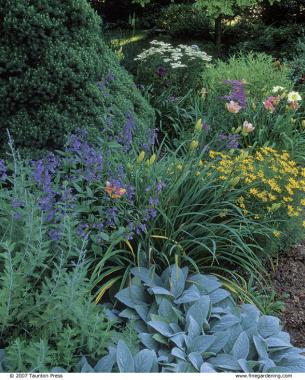
Photo/Illustration: Steve Silk

Often relegated to the status of cooperative supporting player, green offers more than meets the eye. It can easily hold its own when cast in a leading role. I was slow to appreciate the stellar possibilities of green when I began gardening, but I did plant rhododendrons and a few needled evergreens early on. Over the years and through the seasons, they have given me more pleasure than anything else in the garden.
From November to May, the rhododendrons and conifers dominate the landscape. It took the Rhododendron species and cultivars a few years to make a strong visual statement, but the evergreen garden was always a success, even when the golden false cypress (Chamaecyparis pisifera ‘Filifera Aurea’, Zones 4–8) was only knee-high and the bird’s-nest spruce (Picea abies ‘Nidiformis’, Zones 3–8) the size of a sofa cushion. Today, the evergreens have grown together, forming an impressive frieze of dark green, light silver-green, blue-green, chartreuse, and golden-green.
In addition to being surrounded by forest, our garden boasts 11 mature maples (Acer spp. and cvs., Zones 4–9). Although I stopped trying to grow flowers under them years ago, giving up the unequal struggle did not result in sacrifice. I love the shade borders with their carefree ferns, hostas, and hellebores. Of these, many produce appealing flowers, as well as good-looking foliage.
The first to bloom are the hellebores (Helleborus spp. and cvs., Zones 4–9) which bear small clusters of exquisite bowl-shaped blossoms 2 inches across. The five overlapping sepals look exactly like petals and come in lovely tints and shades of off-white, pink, and plum. They last for weeks, but it is the gleaming dark-green foliage that is even more enduring and endearing. Handsome, indestructible, and deer-proof, the leaves form large clumps that look very fine next to the solid leaves of hostas.
While my feelings about the flowers of Hosta species and cultivars (Zones 3–8) are lukewarm, my admiration for the foliage knows no bounds. I could become seriously addicted to this distant relation of the daylily. The variety of sizes, shapes, and shades of green found in hosta leaves is truly mind-boggling. I am particularly enamored of the huge yellow-green leaves of ‘Sum and Substance’ and the bright leaves of ‘Piedmont Gold’. They stand out in the deep shade like shafts of sunlight piercing the forest canopy.
The dainty blue-green foliage of white fumitory (Corydalis ochroleuca, Zones 6–8) makes a lacy edging for the hostas and hellebores. The flowers are insignificant in size, but so numerous and produced over such a long period that they create quite a show among the leafy plants.
Siberian bugloss (Brunnera macrophylla, Zones 3–7), with sprays of small, deep-blue forget-me-not flowers in the spring, has proved a sturdy soul in dry shade. It gets high marks for its mounds of heart-shape, dark-green leaves, which contrast with the pretty light-green foliage of Geranium macrorrhizum (Zones 4–8). This hardy geranium has pink flowers in the spring, but again, it’s the leaves that count.
Although I still love my daylilies and other colorful flowers, I have come to the conclusion that green gardens have it all. My shade plantings are a great deal less trouble than the sunny borders—no staking, no weeding, and a minimum of deadheading. In fact, they are an older gardener’s dream. Cool, peaceful, and inviting, they look attractive, even when I don’t lift a finger. So for a beautiful garden and a restful season, think green.

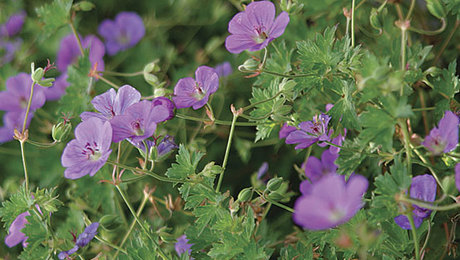
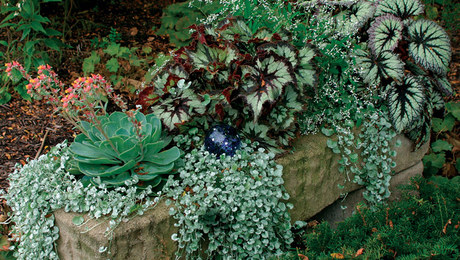
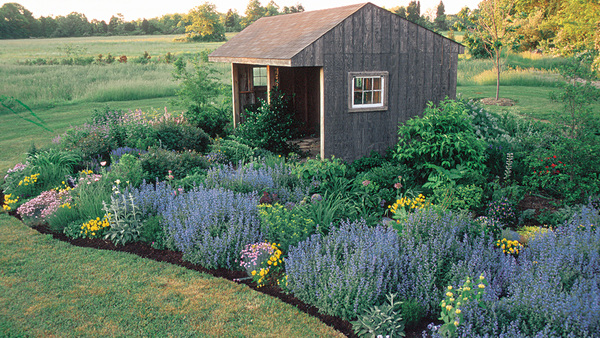
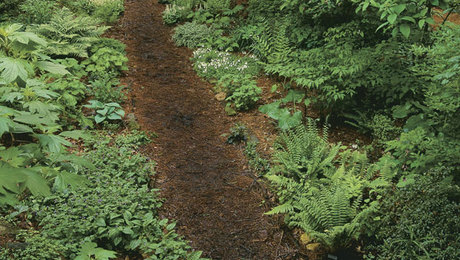













Comments
Log in or create an account to post a comment.
Sign up Log in